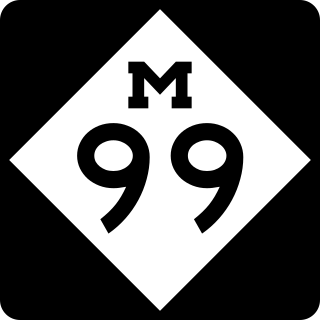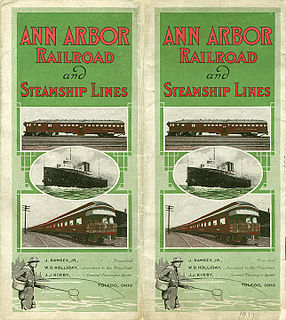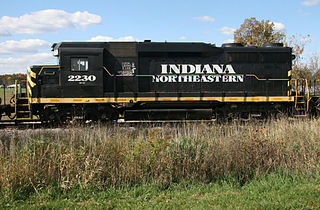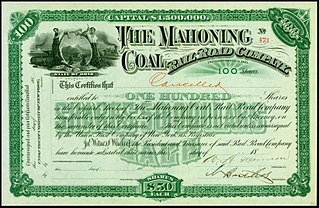
M-99 is a north–south state trunkline highway in the Lower Peninsula of the US state of Michigan. It runs from the Ohio state border, where it connects to State Route 15 (SR 15), north to Lansing, where it terminates at a junction with Interstate 496 (I-496) and the Capitol Loop. The highway mainly serves local communities along the route as it passes through farm lands in the southern part of the state. One short segment, in Jonesville, is routed concurrently with US Highway 12 (US 12). The segment within Lansing follows Martin Luther King Jr. Boulevard.

The Harbor Springs Railway was a 2 ft 6 in narrow gauge railway built at Harbor Springs, Michigan on Little Traverse Bay on Lake Michigan. It was nicknamed the Hemlock Central because of the great numbers of hemlock trees growing in the area. The railway was chartered by Ephraim Shay, the inventor of the Shay locomotive, on February 2, 1902, but may have started construction as early as December 10, 1900.
The Cleveland Short Line Railway is a freight bypass around southern Cleveland, Ohio, in the United States. A quasi-independent railroad organized by major shareholders of the Lake Shore and Michigan Southern Railway, the shortline was intended to allow the Lake Shore and Michigan Southern to bypass the congested railroads in downtown Cleveland. The Cleveland Short Line has had a succession of owners, and is currently part of CSX Transportation.

Amasa Stone, Jr. was an American industrialist who is best remembered for having created a regional railroad empire centered in the U.S. state of Ohio from 1860 to 1883. He gained fame in New England in the 1840s for building hundreds of bridges, most of them Howe truss bridges. After moving into railroad construction in 1848, Stone moved to Cleveland, Ohio, in 1850. Within four years he was a director of the Cleveland, Columbus and Cincinnati Railroad and the Cleveland, Painesville and Ashtabula Railroad. The latter merged with the Lake Shore and Michigan Southern Railway, of which Stone was appointed director. Stone was also a director or president of numerous railroads in Ohio, New York, Pennsylvania, Indiana, Illinois, Iowa, and Michigan.

The Manistique and Lake Superior Railroad (M&LS) was an American Class III railroad serving the Upper Peninsula of Michigan from 1909 to 1968. It provided service from Manistique, Michigan to a junction with the Duluth, South Shore and Atlantic Railway at Doty, Michigan, southeast of Munising, Michigan. Its nickname was The Haywire.

Railroads have been vital in the history of the population and trade of rough and finished goods in the state of Michigan. While some coastal settlements had previously existed, the population, commercial, and industrial growth of the state further bloomed with the establishment of the railroad.

The Indiana Northeastern Railroad is a Class III short line freight railroad operating on nearly 130 miles (210 km) in southern lower Michigan, northeast Indiana and northwest Ohio. The Indiana Northeastern Railroad Company began operations in December 1992 and is an independent privately owned company. As of 2017 the railroad hauled more than 7,000 carloads per year. Commodities moved by the railroad include corn, soybeans, wheat and flour. It also handles plastics, fiberboard, aluminum, copper, coal, perlite, stone, lumber, glass, rendering products, as well as agricultural fertilizers and chemicals.

The Chicago, Kalamazoo and Saginaw Railway (CK&S), known informally as the "Cuss, Kick & Swear" is a defunct railroad which operated in southwest Michigan in the late 19th and early to mid 20th centuries. Despite the name, the line ran entirely within the state of Michigan, with the majority in Kalamazoo County. It eventually became part of the New York Central. As of 2010, most of the former CK&S tracks have since been abandoned.
The Detroit, Lansing and Northern Railroad (DL&N) is a defunct railroad which was formed on December 27, 1876 as a reorganization of the foreclosed Detroit, Lansing and Lake Michigan Rail Road. The segment of its main line from Detroit to Lansing became an important component of the Pere Marquette Railroad, organized in 1900, and is still in use by CSX.
The Chicago and West Michigan Railway (C&WM) is a defunct railroad which operated in the state of Michigan between 1881 and 1899. It was one of the three companies which merged to become the Pere Marquette Railway.
The Chicago and Michigan Lake Shore Railroad (C&MLS) is a defunct railroad which operated in Michigan between 1869 and 1878, and as the Chicago and West Michigan Railroad until 1881.
The Grand Rapids, Newaygo and Lake Shore Railroad is a defunct railroad which operated in the state of Michigan between 1872 and 1881. The GRN&LS was chartered on September 11, 1869, under the leadership of David P. Clay. The company operated a 46-mile (74 km) line between Grand Rapids and White Cloud. The initial segment, from Grand Rapids to Sparta, was completed on May 19, 1872. The line reached Newaygo on September 11, 1872; the first passenger train between the two towns ran the same day, to much fanfare from the local populace. On September 24, 1875 the line was extended over the Muskegon River to White Cloud. On September 30, 1881, it consolidated with other companies to form the Chicago & West Michigan. During its twelve years of independent existence the company sustained a net loss of $36,554.28.
The Grand Rapids, Kalkaska and Southeastern Railroad is a defunct railroad which operated in Northern Michigan toward the end of the 19th century. The company was founded on August 30, 1897 by William Alden Smith, a Republican politician and former general counsel of both the Chicago and West Michigan Railway and the Detroit, Lansing and Northern Railroad. The GRK&S constructed a 40.73-mile (65.55 km) line from Stratford in northern Missaukee County through Kalkaska to Rapid City, where it met the C&WM's main line. The C&WM undertook to supply rolling stock and oversee construction in exchange for a 10-year lease of the line.
Michigan United Railways (MUR) was an interurban which owned and leased numerous lines in the state of Michigan during the early twentieth century.
The Grand Rapids, Belding and Saginaw Railroad is a defunct railroad which operated in the state of Michigan at the turn of the 20th century.
The Mason and Oceana Railroad (M&O) was a short common carrier, 3 ft narrow gauge logging railroad in the U.S. state of Michigan. Organized in 1887 and in operation from 1887 until 1909, it served the counties of Mason and Oceana in the northwestern quarter of Michigan's Lower Peninsula in the late 19th and early 20th centuries.

The Mahoning Coal Railroad (MCR) was a railroad line in the U.S. states of Ohio and Pennsylvania. Incorporated in 1871, it largely linked Youngstown, Ohio, with Andover, Ohio. It had a major branch into Sharon, Pennsylvania, and several small branches and spurs to coal mines and iron works along the Ohio-Pennsylvania border. The railroad leased itself to the Lake Shore and Michigan Southern Railway in 1873. The lease was assumed by the New York Central Railroad in 1914, when that company consolidated with the Lake Shore & Michigan Southern. The New York Central merged with the Pennsylvania Railroad in 1968 to create the Penn Central. Despite abandonment of much track, bankruptcy of the Penn Central in 1970 eventually caused the MCR's dissolution on January 7, 1982.
The Jamestown and Franklin Railroad (J&F) was a shortline railroad which operated in the U.S. states of Ohio and Pennsylvania. Established in 1862, its main line ran from Jamestown, Pennsylvania, to Oil City, Pennsylvania. A branch line connected Jamestown with Ashtabula, Ohio. The railroad leased itself to the Lake Shore and Michigan Southern Railway in 1864 for 20 years. A 1909 consolidation with three other railroads created the Jamestown, Franklin and Clearfield Railroad, and ended the J&F's existence.

The Detroit, Monroe and Toledo Railroad (DM&T) was a shortline railroad which operated in the U.S. states of Michigan and Ohio. Opened in 1856, its main line ran from Detroit, Michigan, to Toledo, Ohio. The railroad leased itself to the Michigan Southern and Northern Indiana Railroad (MS&NI) in 1856. A 1914 merger which created the New York Central Railroad led to the DM&T's consolidation into the new road, ending its existence.
The Kalamazoo and White Pigeon Railroad (K&WP) was a shortline railroad in the U.S. state of Michigan. The line ran from Lansing to Jonesville, then returned north from Jonesville to Albion and Eaton Rapids before closing the loop in Lansing. The NCMR had a short life as an independent company, becoming part of the Lake Shore and Michigan Southern Railway in 1871 and then consolidating with the New York Central Railroad in 1914.









